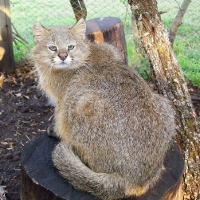 |
Pantanal Cat |
|
He is a wild animal |
Origin |
South America | |
Translation |
Francis Vandersteen |
| The possession of this animal is not authorized Royal Decree establishing the list of mammals not kept for production purposes that may be kept (M.B. 24.08.2009) |
| The Pantanal Cat is a cat species or subspecies of the Pampas Cat. About the size of a domestic cat, the Pantanal Cat is a small feline with a fawn to brown coat, marked with more or less distinct spots on the flanks and dark stripes on the legs and tail. Melanism has been reported both in the wild and in captivity. The Pantanal Cat is a small feline, about the size of a domestic cat. The coat is yellowish to brown, with dark brown spots on the flanks, a lighter throat, two dark lines on each cheek, black stripes on the legs and chest, black feet and a black tail tip. The ears are large, dark gray to black, sometimes with a lighter mark on the outside. A case of melanism has been noted only once in Brazil, although black individuals have been observed in captivity. Two subspecies exist on the basis of coat pattern. Leopardus braccatus braccatus is almost entirely rusty-brown with blurred spots, continuous tail stripes, black tips and entirely black feet. Leopardus braccatus munoai is paler and more yellowish, with sharper, browner spots on the flanks, discontinuous rings on the tail with a smaller black tip, and black feet only on the soles. The Pantanal Cat is diurnal, solitary and territorial. Its territory ranges from 3 to 37 km2. It is a predator of small mammals such as guinea pigs, birds, small lizards and snakes. Although still poorly understood, the Pantanal Cat's biology and behavior is probably similar to that of the Colocolo. The Pantanal Cat's range extends across central-eastern Brazil, Uruguay and neighboring Bolivia, Paraguay and Argentina. This cat lives from sea level to 2,000 meters above sea level. The Pantanal Cat owes its name to the Pantanal, a wetland in central South America, but its habitat is highly varied. In Brazil, the Pantanal Cat occupies subtropical forests, open woodlands and grasslands. In Paraguay, fruticaceous forests and scrubland. In Uruguay, swampy areas. Sightings have been reported in farmland, showing that this feline has a certain tolerance to human disturbance. Photo traps set in Emas National Park have shown that the Pantanal Cat is fairly common in the park. The main threats to the Pantanal Cat are the conversion of its habitat to farmland and the modification of grasslands by cattle. It is occasionally trapped to protect poultry from predation, and is a frequent victim of road accidents. The International Union for Conservation of Nature considers the Pantanal Cat to be a subspecies of the Pampas Cat (Leopardus colocolo), classified as "Near Threatened" (NT) due to the significant reduction in its habitat. Resolving the taxonomic status of the Pampas Cat is seen as an important issue in safeguarding these felines. The Pantanal Cat is endangered in Uruguay due to excessive human pressure, and populations in Brazil are considered vulnerable. Hunting is prohibited in Bolivia and Paraguay. CITES considers the Pantanal Cat to be a species and lists it in Appendix II. |






 English (United Kingdom)
English (United Kingdom)